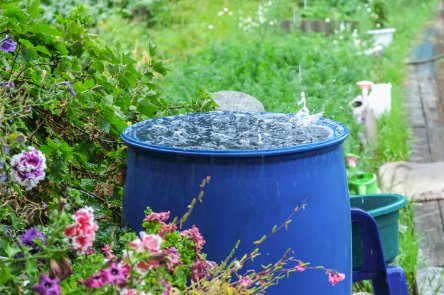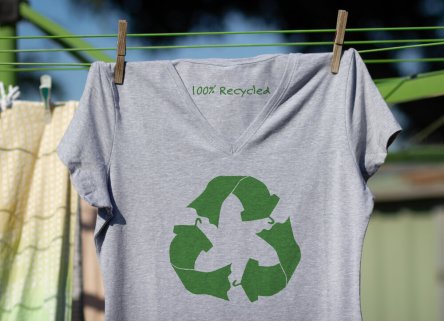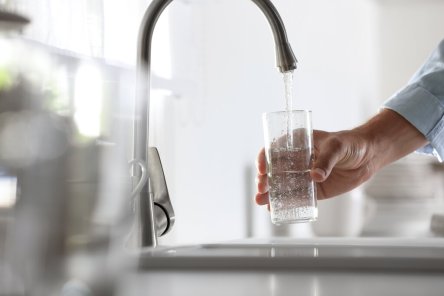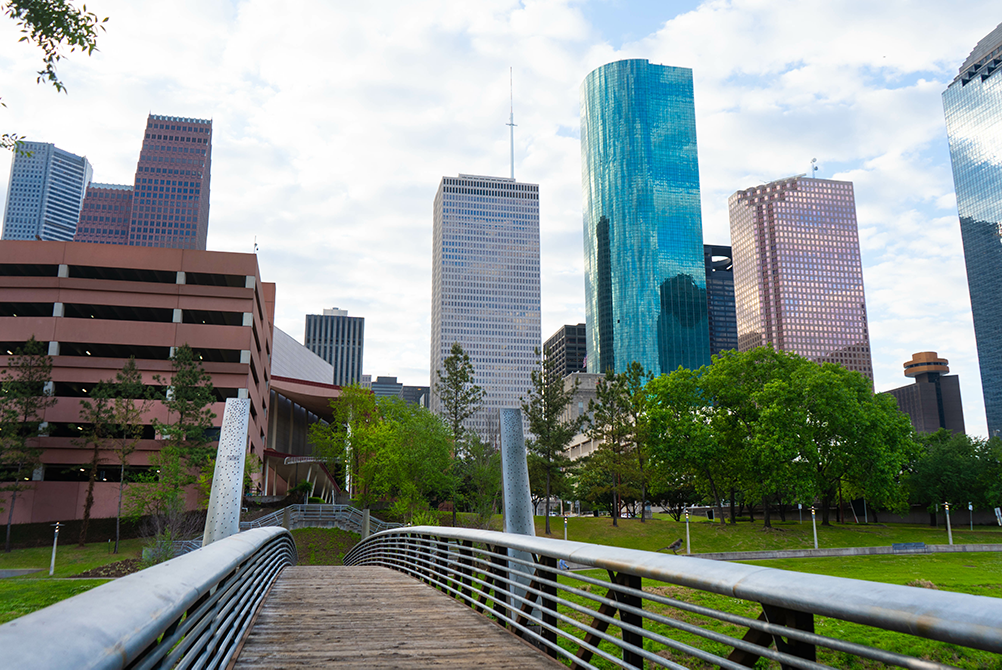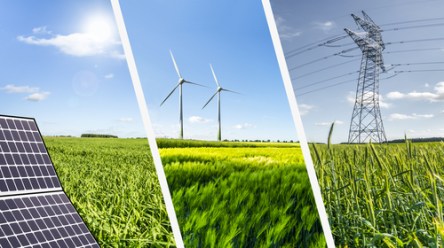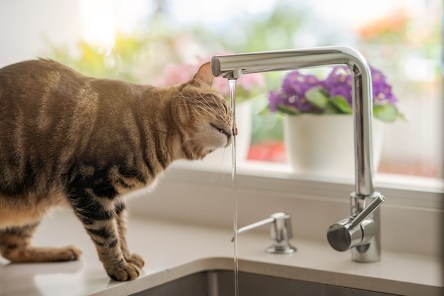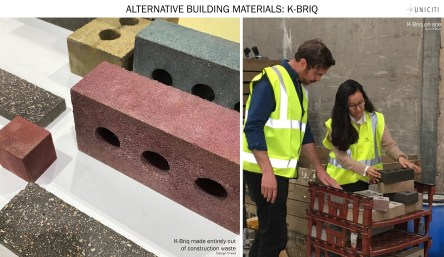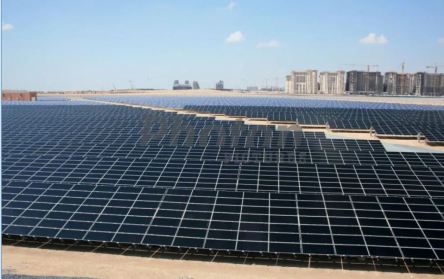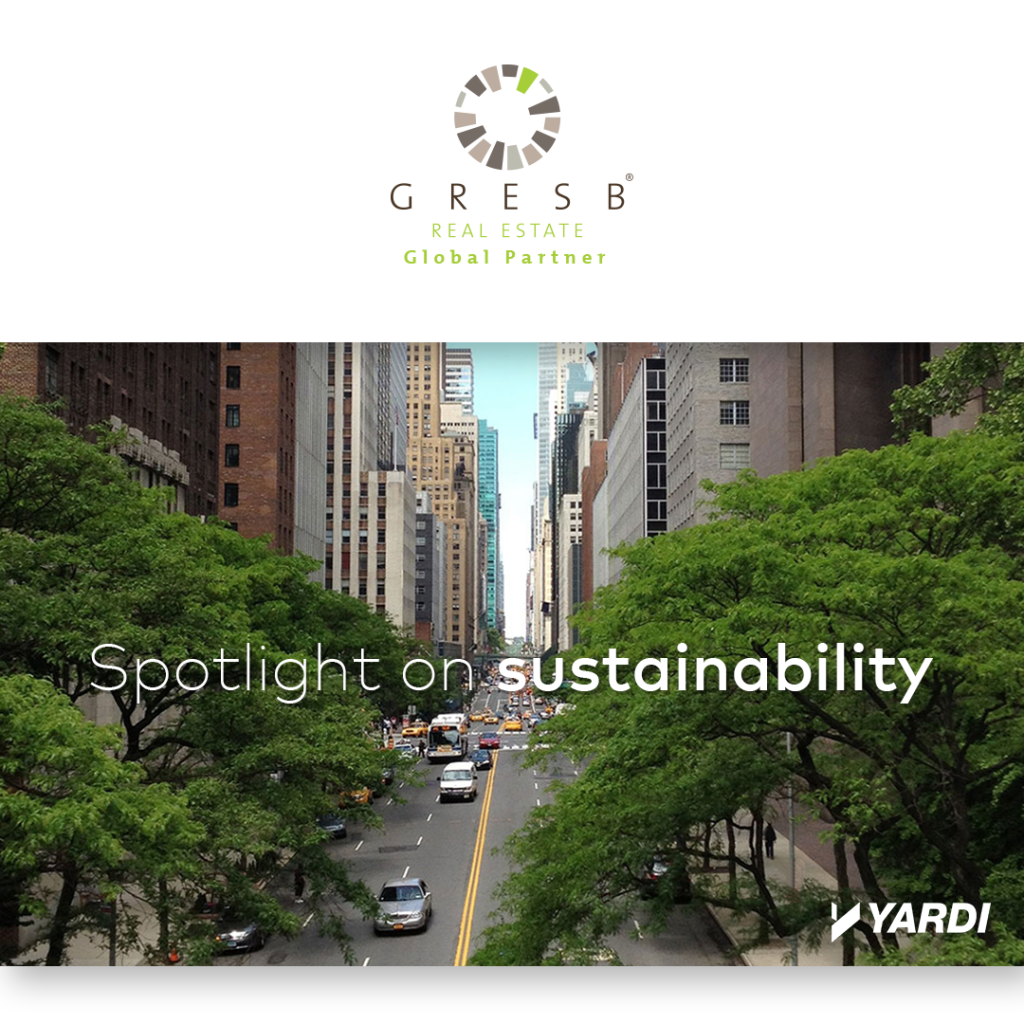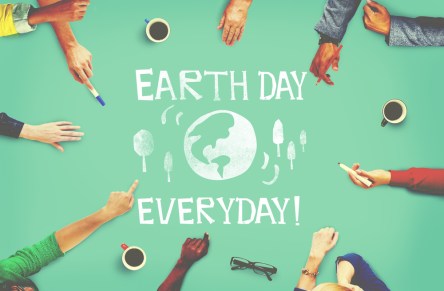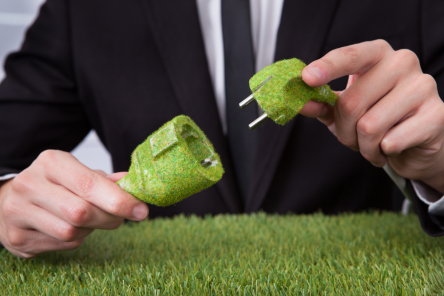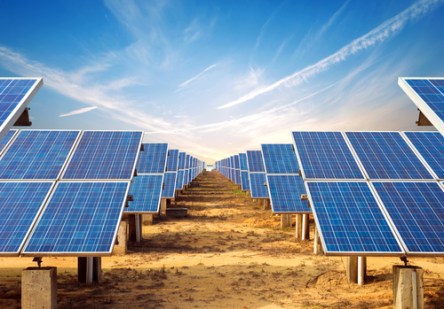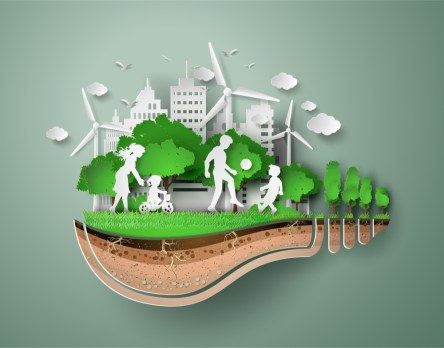For many CRE operators, the future is green. Businesses of all sizes are achieving sustainability by leveraging software for sustainable buildings. The latest tech offers detailed consumption insights, automates resource optimization, promotes waste reduction and engages occupants through access to building performance data. How facility management software drives sustainability Facility management tech is transforming how the industry monitors, manages and maintains facilities. Eco-minded strategies utilizing the latest software tools aim to reduce a building’s environmental footprint, conserve resources and promote energy efficiency. Traditionally, managing a building’s environmental impact required manual processes, making it challenging to monitor resource usage in real time. Now, with sophisticated software, facility managers can track, analyze and adjust environmental metrics instantly. These software tools integrate with building systems — such as heating, ventilation, air conditioning (HVAC) and lighting — and provide real-time data on energy usage, water consumption and other critical resources. By consolidating data in one platform, facility managers gain a holistic view of a building’s performance, allowing them to make data-driven decisions that reduce waste and improve sustainability. Key features of eco-friendly facility management One of the main ways software aids in sustainable facility management is through energy monitoring and optimization. With detailed insights into energy consumption, facility managers can identify high-usage areas and adjust operations accordingly. Some software for sustainable buildings can provide predictive analytics and artificial intelligence to optimize energy use, automatically adjusting HVAC settings and lighting based on occupancy or weather patterns. By reducing unnecessary energy consumption, facilities can significantly lower their carbon footprint and cut down on utility costs. Water management is another critical focus of eco-friendly facility management. Leaks, excessive water use and inefficient plumbing fixtures all contribute to environmental impact. Software solutions can detect irregularities in water usage and automatically alert facility managers, allowing...
Exploring America’s Aquariums
Aquatic Animal Care
Aquariums, often a topic of debate among some, are more than just attractions. Did you know that most aquariums are nonprofit organizations firmly committed to conservation and sustainability? This summer, let’s dive into the world of America’s top aquariums and discover the incredible work they do. Georgia Aquarium, Atlanta. This aquarium, the largest in the Western Hemisphere, is not just a home to the majestic whale sharks but also a hub of groundbreaking research. Since 2004, the aquarium has been studying whale sharks in the wild, an unparalleled research opportunity. The DNA studies conducted by scientists at the Georgia Institute of Technology, based on tissue samples collected from the animals at the aquarium, have led to the first-ever complete shark genome map. In addition to whale sharks, the Georgia Aquarium is a leader in conservation efforts for endangered species, sharing the experience and knowledge from innovative strategies to effective on-the-ground action. Former president and CEO of Georgia Aquarium, Dr. Brian Davis, said, “Georgia Aquarium has been at the forefront of aquatic science for years, making important breakthroughs for marquee marine species. Our commitment to protecting our ocean is unwavering.” Monterey Bay Aquarium, California. This gorgeous aquarium is known for its 28-foot-tall Kelp Forest, one of the tallest aquarium exhibits in the world! In addition to the Kelp Forest, Monterey Bay offers tufted puffins, sea otters, and deep-sea animals, including transparent glowing jellyfish. As far as sustainability is concerned, Monterey Bay Aquarium is committed to reducing sources of ocean plastic pollution. It practices what it preaches by ensuring all its retail operations and the products it sells align with its mission. By the end of 2024, the aquarium is working toward its apparel made from synthetic blends. Plush toys are all made with 100% recycled materials. And at the end of 2023, they eliminated 100% of hard plastic toys and gift products. National Aquarium, Baltimore. The National Aquarium attracts over 1 million visitors annually to view its more than 20,000 aquatic animals, including an interactive and fully immersive dolphin show. However, such a large, resource-heavy production takes a lot of energy. The institution has committed to reducing its greenhouse gas emission to net zero by 2035, including some activities such as tree-planting projects to help address climate change. Laura Bankey, the aquarium vice president of conservation programs, says, “We feel it’s important as a leader in the industry and as a leader in Baltimore to show people that it can be done and must be done. Going all in on climate means every decision that we make in the future has to use climate change as a filter.” Shedd Aquarium, Chicago. This aquarium aims to promote compassion for animals and conservation efforts with an up-close view of an array of aquatic animals, including giant Pacific octopuses. They also offer a conservation eco-tour in the summertime with guided kayaking outings on the Chicago River. Shedd Aquarium is also committed to supporting sustainable fisheries to benefit the ecosystem and all that rely on them. Shedd also grows organisms like zooplankton at the bottom of the food chain through a live foods program. Live foods reduce the need to source food from the ocean and decrease the packing waste and carbon footprint generated from shipping food. Shedd Aquarium just welcomed its newest baby, a Beluga whale, last month, the firstborn since 2020. Births at aquariums like Shedd provide invaluable insights for scientists and conservationists alike. Tennessee Aquarium, Chattanooga. Visitors to this top Chattanooga attraction embark on an underwater adventure from the mountains to the sea. This unique aquarium is divided into two buildings for freshwater and saltwater exhibits. The aquarium conducts several scientific studies by restoring the region’s natural ecosystems and educating the public to take conservation action. With its riverfront facility, the aquarium is growing its capacity to actively protect the health of the river water and the fantastic, diverse animals. A...
Go Green Team
Sustainability & the Olympics
Sustainability has become a vital focus for the modern Olympic Games, aiming to reduce environmental impacts and promote long-term benefits for host cities and the planet. Let’s delve into some of the essential areas of focus. Green infrastructure. The future host cities for the Olympics are not just accelerating sustainable strategies but also making a significant positive impact on the environment. They are advancing sustainable sourcing, building energy-efficient and eco-friendly sports venues, using renewable energy sources, and implementing waste reduction practices. This is a guiding light for a greener future. For example, in 2020, Tokyo is notable for using recycled materials for medals and sustainable sourcing of wood for venues. They had sustainable construction out of the 43 venues, either renovated or retrofitted with advanced technology to reduce energy consumption. Twenty-five of the venues were reused buildings from the 1964 Games, including the jewel Yoyogi National Stadium, designed by Japan’s most famous architect, Kenzo Tange, recognized as a prominent modernist architect. Transportation and waste management. Sustainability involves transportation and promoting public transit, cycling and walking to help these larger host cities reduce carbon emissions, especially with the increased population. Host cities should consider investing in sustainable transportation infrastructure, such as enhancing electric vehicle use by expanding charging infrastructure and adopting uniform charging connectors that can significantly reduce carbon emissions—or adding more pedestrian bridges, allowing individuals to cross busy intersections or waterways in an environmentally friendly way. Cities should also implement comprehensive recycling and waste reduction programs to eliminate waste in landfills. Biodiversity and green spaces. At a mega event like the Olympics, host cities must learn how to protect and enhance local biodiversity, create green spaces and ensure minimal ecological disruption. This year, the Summer Olympics in Paris aims to be the most...
Pollinator Awareness
The Bee’s Tea
Understanding how urban areas and technology can significantly support and protect pollinator populations is important. Let’s explore the world of pollinators and their significant economic impacts worldwide. History perspectives. Our history is intertwined with that of pollinators. Ancient cultures, such as those in Egypt, Mesoamerica, Greece, and Rome, revered and utilized pollinators in various ways, reflecting their profound importance throughout history. Bees, for instance, were domesticated for honey and beeswax and held symbolic significance in Egyptian mythology and art. The role of stingless bees in Mayan and Aztec cultures was studied for honey production and religious rituals. Bees were used in ancient Greece and Rome for agriculture, medicine, and mythology, with references in literature and the development of early beekeeping techniques. Economic impacts. The role of pollinators in the economy is often underestimated. Crops such as almonds, apples, avocados and coffee rely on pollination. In fact, according to the National Library of Medicine, 75 percent of crop species benefit from animal pollination for fruit or seed set and yield. Pollinators have a tangible monetary value. For example, in the United States, pollinators contribute billions of dollars to the economy annually. They also indirectly support jobs in agriculture, food production and retail. A declining population could lead to significant economic losses, increased manual pollination costs, and reduced crop yields. This underscores the urgent need for their conservation. Urban areas can be significant allies in the fight to protect pollinators. With thoughtful planning and community engagement, urban habitats like green spaces, community gardens, and rooftop gardens can become vital refuges for pollinators. Many cities are already implementing policies and initiatives to increase pollinator-friendly spaces, such as the Million Pollinator Garden Challenge. This initiative encourages the creation of pollinator-friendly gardens and landscapes to help revive the health...
Rainwater Harvesting
Reap What You Flow
An age-old conservation practice is attracting renewed interest in this era of drought and unpredictable precipitation: rainwater harvesting, the process of capturing, diverting and storing rainwater for later use for residential use, landscaping, fire protection and other purposes. Valued at $890 million in 2021, the global rainwater harvesting system market is projected to top $1.6 billion by 2030, with North America accounting for more than a third. Rainwater harvesting today ranges from simple rain barrels to elaborate capture and storage systems complete with pumps, piping and filtration elements. In whatever way it’s practiced, rainwater harvesting is “one of the best examples of green building practices,” says business research firm Technavio. “Complex installations are best left to professionals knowledgeable about restrictions and permit requirements, but if your goal is a free water source for lawn, garden and other activities, harvesting rainwater is fairly straightforward,” adds The Spruce, an online source for home decorating and repair. A 2,000-square-foot roof can collect about 1,100 gallons of water from just one inch of rain. With the average American household using around 300 gallons per day, that inch could supply a household with water for almost four days. The two principal types of rainwater collection are surface runoff, which funnels water from a flat surface into a storage container, and rooftop runoff, which involves positioning a barrel or other storage container beneath a building downspout. Harvesting components include gutters and other channeling conduits, filters that remove debris, water level monitors and pumps. Additional filtration and disinfection, along with any required local or state government permits, can product potable water. While rain harvesting is most commonly used for residences, “the global non-residential rainwater harvesting systems market is expected to grow at a moderate rate due . . . the non-residential...
Eliminate Paper Waste...
Tech saves the planet
Paper has long been a mainstay of virtually every business. But amid cost and environmental concerns, many companies are starting to examine alternative approaches that can reduce paper use and waste. Worldwide consumption of paper has risen by 400% in the last 40 years, with 35% of harvested trees being used for paper manufacturing. Every year, U.S. offices use more than 12 trillion sheets of paper, according to The World Counts, an advocate for sustainable natural resources consumption. The U.S. Environmental Protection Agency reports that office paper products such as handouts, copy paper, and notebooks make up the largest percentage of landfill waste. Even with the business world becoming more digitized, the EPA says the average office worker generates approximately 2 pounds of paper and paperboard products every day: “From mistakes printed on the laser printer, bad photocopies, old memos and reports, to old periodicals, 90% of all office waste is paper.” But new technologies and approaches can help break the reliance on paper. “Until recently, there was no doubt that we needed to use paper on a daily basis. However, we now have alternatives at our disposal that can help us reduce paper consumption in the office, and by applying digital tools and new work habits,” says ACCIONA, a Madrid-based chronicler of workplace trends. Here are some tips from sustainable experts for making better use of paper and reducing waste: Consider advanced software solutions such as the Yardi Procure to Pay Suite, which cuts paper costs with online purchasing, electronic invoice processing and payment and centralized vendor management; Yardi Payment Processing, a complete solution for commercial property management accounts receivable and accounts payable; and Yardi Document Management for SharePoint, which replaces uncoordinated storage on local drives and networks with a single source of...
Sustainability for All
Simple Earth-friendly Living
Green is always good. Every action taken throughout the day has an impact on the planet. Here are some simple tips to be sustainable in everyday life, which are tremendous ways to become more eco-friendly. Eat more greens. Everyone wants healthy longevity, and eating more plants is how to get there. Going vegan overnight is impossible, but gradually incorporating at least two or three days of meatless meals can make a difference. Half of the world’s habitual land is used for agriculture, which only gives the world 18% of global calories. It releases most land use, cattle methane emissions, manure management, and fertilizer use. Reduce your carbon footprint by eating more plant-based foods like tofu, beans, nuts, and foods with the lowest environmental impact, like whole grains, olive oil, fruits, and vegetables. You can now find more sustainable wine and beer using organic farming and zero-waste commitments. Sustainable foods are local, seasonal foods grown without hazardous pesticides and chemicals and support the local economy, which offers jobs and builds stronger communities. Save water. Agriculture also requires much freshwater, which can cause significant environmental pressures in regions with water restrictions. Saving water is another effective way to reduce electricity use, greenhouse gas emissions, and other energy-intensive operations. For example, try at home to only run the dishwasher with a full load and the same with full loads of clothes in the washer. Reuse water by keeping some buckets outside to catch rainwater and use them to water plants in the coming days. Cold showers use less energy, and thanks to Wim Hof Method, so has cold therapy, which gives the body immense health benefits. Recycle. Depending on where you live, recycling options will vary and programs may be more comprehensive in some states or cities than elsewhere. Try to separate trash and follow the local recycling guidelines. Reuse items as often as possible before throwing them out. Sustainable reusables. 50% of all plastic produced is for single-use purposes. As a result, 10 million tons of plastic are dumped in oceans annually. Using so much single-use plastic is entirely unnecessary when there are many sustainable alternatives. Reduce trash by being more conscious of consumption and waste patterns. For example, consider getting reusable water bottles instead of multiple plastic bottles, reusable utensils, and containers. Always remember to bring your reusable tote bags for groceries. Since the spring holiday, Easter, is coming up, skip the plastic grass for the baskets and opt for some Spanish moss or other biodegradable grass or crinkled paper. Plastic grass lasts forever in the environment, not to mention it’s dangerous for pets that might get ahold of a basket. Eco-friendly cleaning. Let’s face it, home cleaning product chemicals are terrible for the environment and your body. By choosing eco-friendly cleaning products, you will reduce the amount of plastic packaging used and the number of chemicals that flow into the oceans. Vinegar is a pantry cleaning staple known to cut grease and dissolve hard water stains. If the smell is too much for some, add some essential oils, such as lavender, pine, or lemon balm. Pine and lemon oils are great alternatives for floor cleaners which is how Pine Sol was created in the early 1900s. Baking soda is an eco-friendly product with many benefits. Sprinkle it directly on hard surfaces that need extra stain removal. Baking soda can also absorb odors. Use it in the refrigerator, freshen mattresses, pet beds, and shoes, and it can even be added to the wash and rinse cycle to deodorize clothing. Vinegar and baking soda, together, will go a long way when cleaning bathroom tubs, sinks, kitchen appliances, and faucets. Laundry soaps are terrible for the oceans. Tide now has an eco-friendly laundry detergent that contains 75% plant-based ingredients. In addition, the formula is free of dyes, chlorine, and optical brighteners and is produced at a zero-waste-to-landfill manufacturing site using 100% renewable...
Sustainable Fashion
Changing Mindsets
When one thinks about big sustainability impacts, agriculture, energy production and other brawny industries often come to mind. But the manufacture, transport and disposal of t-shirts, pajamas, blouses and other garments create a sizeable footprint too. In fact, garment production and transportation account for up to 10% of global greenhouse gas emissions, more than the aviation and shipping sectors combined. Growing and dyeing clothing material consumes 93 billion metric tons of clean water globally each year, about half of what Americans drink annually. Scientists estimate that 35% of the microplastics in the world’s oceans, which can take hundreds of years to decompose, can be traced to textiles. Three-quarters of shirts and shoes end up burned or buried in landfills. Less than 1% of clothing is recycled into new garments and over 25% of returned items end up being thrown out. “Because it is hard to make a better performing or more efficient blouse, handbag, or pair of socks, to motivate consumption, the industry pushes change. Not better — just different, cheaper, or faster,” said Kenneth P. Pucker, former COO of footwear manufacturer Timberland, writing in Harvard Business Review in January. ‘The biggest issue’ for the industry Statistics like these are why Judith Magyar, a brand contributor to Forbes, describes sustainability as “arguably the biggest issue confronting fashion brands right now.” The industry, she says, “is waking up to the fact that decreasing its environmental impact will pay big dividends to both its constituent companies as well as society at large.” Rising environmental, social and governance scrutiny is one reason for this growing awareness. “Younger consumers value transparency, honesty and authenticity. Companies that are upfront with their products — everything from where and how they are manufactured to the materials used and the environmental impact — may...
Sports Arenas
Score Sustainability Points
Sports arenas attract vast attention with their aesthetic qualities, luxurious amenities, association with high-profile teams and iconic imprint on city skylines. But did you know that beyond their opulence, many modern arenas represent leadership in sustainability? “Many sports venues have jumped on the sustainability bandwagon to construct or renovate their structure in a race to minimise their carbon footprint, preserve their green legacy and take the lead in innovation,” says London-based Climate Action, which partners with business, government and public entities on sustainability projects. Sports arena sustainability is a global trend. Examples include: The Johan Cruijff ArenA (formerly Amsterdam ArenA), home of the Ajax football club. The Netherlands’ largest stadium employs more than 4,200 solar panels and a wind turbine. Its main building includes an energy-generating escalator and an energy system powered by second-life batteries from used electric vehicles.Mercedes-Benz Stadium, where the NFL’s Atlanta Falcons play their home games. In November 2017, soon after it opened, Mercedes-Benz became the first professional sports stadium to receive a platinum Leadership in Energy & Environmental Design (LEED) certificate for meeting rigid standards for carbon, energy, water, waste, materials and other factors. The arena’s energy consumption is reportedly 29% less than what the average stadium consumes thanks to LED lighting and 4,000 rooftop solar PV panels. A stormwater management system can store over 2 million gallons onsite, preventing flooding in surrounding areas.Levi’s Stadium in Santa Clara, Calif. The home of the NFL’s San Francisco 49ers since 2014 has earned two LEED certifications, including the first Gold LEED certification awarded for a stadium that hosts a professional team, plus a second Gold certification for operations and maintenance. Levi’s also incorporates 1,000 solar elements and sources 78% of its food from within 150 miles of the stadium. Seattle’s Climate Pledge...
Conservation Ideas
World Water Day: March 22
World Water Day has continued to draw attention to the importance of conserving fresh water since our report on the annual observance four years ago. With the United Nations reporting that 2.2 billion people lack access to safe water, preserving the 0.5% of the world’s water that’s available fresh is a more urgent priority than ever. Created by the UN and observed on March 22 every year since 1993, World Water Day focuses on sustainable management of freshwater resources, with a different theme every year: groundwater this year, valuing water last year, water and climate change in 2020, leaving no one behind in 2019. “These observances aim to highlight that water and sanitation measures are key to poverty reduction, economic growth, and environmental sustainability,” notes the Indian Express news service. Like many conversation efforts, small efforts close to home can yield big results. Consider these tips from the U.S. Environmental Protection Agency and other experts: Repair leaky faucets, indoors and out. The EPA says installing water-efficient fixtures and applicants can cut water use by at least 20%. Check your meter, don’t running water in the house then check two hours later. If the reading moved, there’s a leak. Monitor your water bill for unusually high use. Consider replacing old washing machines, dishwashers and other equipment with more efficient models. Look for appliances and systems with ENERGY STAR® or WaterSense® labels.Eliminating just one load of dishes per week can save nearly 320 gallons of water annually. Replacing a clock-based irrigation controller with a WaterSense-labeled one can reduce an average home’s use of irrigation water by up 30% and save up to 15,000 gallons of water annually. Just turning off the tap while brushing your teeth can save eight gallons per day.WaterSense showerheads can save $70...
Prologis + Sustainability
Ahead of What’s Next
Logistics and construction are among the top ten most environmentally hazardous industries in the world. Rather than accept the status quo, some industry leaders are driving the effort to a healthier tomorrow. Yardi client Prologis is pushing the envelope on sustainability measures in logistics real estate. Prologis receives royal honors for sustainability measures His Royal Highness The Prince of Wales recently recognized Prologis for its dedication to sustainability. The Sustainable Markets Initiatives, with HRH as figurehead, bestows the Terra Carta Seal to just 45 companies in the world that have “set our planet on a fundamentally more sustainable trajectory.” Regarding the honor, the Prince of Wales said: “The Terra Carta Seal recognizes those organizations which have made a serious commitment to a future that is much more sustainable, and puts Nature, People and the Planet [sic] at the heart of the economy. We all need to make changes if we are to preserve the planet for our children and grandchildren and these businesses have pledged to make it easier for us all to do so.” Prologis leads the initiative of sustainable logistics with decades of concentrated efforts. The organization has become the largest developer and operator of logistics real estate due in part to its commitment to efficiency and progressive technologies. Prologis aims to become 100% carbon neutral in just three years. Prologis co-founder and CEO Hamid R. Moghadam said, “We’re pleased to join His Royal Highness, The Prince of Wales, and the Sustainable Markets Initiative’s work to help shape a more sustainable future for all.” He continued, “This is something we have long practiced at Prologis. It is simply doing our part to create a better, cleaner world for this generation and for generations to come.” Prologis welcomes new leadership for the new frontier Prologis appointed Susan Uthayakumar as chief sustainability and energy officer, a new role that serves the organization’s customer-focused sustainability and energy solutions business. Uthayakumar and her team will analyze and develop current and emerging energy solutions. Her team will also collaborate with the company’s divisions for environmental stewardship, social responsibility and governance (ESG). Together, they will enhance strategies on stakeholder engagement. Uthayakumar explained, “Customers today are looking for a partner who can help them achieve their sustainability goals in innovative new ways while running their businesses as effectively as possible.” She adds, “That will be my focus at Prologis.” Prologis Chief Operating Officer Gary E. Anderson said, “Susan’s proven leadership and experience will be critical to our ongoing innovation and progress on our long-term sustainability goals – and those of our customers.” Read more on sustainability at...
Clean is the New Green
Creating healthier buildings
Back in 1946, we were on to something. The American Standards Association, now the American National Standards Institute, issued guidelines for healthy buildings. Among the standards stood a novel concept: occupied rooms should have access to fresh air. It seems like common sense now, but it’s not common practice today. That standard was all but forgotten by 1981 and the repercussions haunt us through the pandemic. Fortunately, a new class of experts highlights the benefits of healthy buildings as a way to promote public health and improve asset value. Introducing Joseph Allen, breathing new life (and science) into old ideas Joseph G. Allen is an assistant professor at the Harvard T.H. Chan School of Public Health. He is also the faculty advisor to the Harvard Healthier Building Materials Academy. During NMHC OPTECH 2020, Allen lead the session “Clean is the New Green.” He guided participants through the numerous ways in which buildings can prevent the spread of germs, promote health and yield higher returns for investors in the process. His session brought participants back to December 2019. Allen and his peers wrote an article on the importance of healthy buildings research to advance health. SARS and other epidemics inspired the paper, but they had no idea how close they were to the brink of a pandemic. “We had narrow misses in the past, influenza epidemics that were nearly pandemics. We knew that we were overdue, and we knew that buildings would play a role,” says Allen. Less than a month later, COVID-19 hit the U.S. By the end of the season, the pandemic had the globe in its grips. Allen and his team worked tirelessly to educate the public on the role that enclosed spaces play in the transmission and prevention of disease. “We have to understand first how we are exposed, and then we can simply line up the corresponding control strategies, like higher ventilation, better filtration and use of masks,” says Allen. Controlling exposure points begins with the air The potential for close contact transmission, contaminated surfaces and airborne transmission must all be addressed in healthy buildings. Airborne transmission is the trickiest to manage. Smaller airborne particles can linger in the air for 30 minutes. They can travel beyond six feet with studies showing “viable virus as far as 16 feet,” reports Allen. Creating a healthy interior space requires more than social distancing. “In each outbreak, people were indoors with no masks and low to no ventilation. This is so important because airborne transmission is what drives super spreader events,” explains Allen. “A study published just last year found that ensuring even minimum levels of outdoor air ventilation reduced influenza transmission as much as having 50 % to 60 % of the people in a building vaccinated,” says Allen. Buildings can help to reduce the spread of disease through intentional ventilation and filtration techniques. Builders and managers acknowledged this fundamental truth in the late 1940s. By the early 1980s, however, efforts to reduce energy consumption lead to poorer indoor air quality. “We’ve lost our way over time,” explains Allen. “We’ve placed the emphasis only on energy. As a result, we are here in the sick building era where buildings can’t respond to the crisis at hand. They can’t bring in outdoor air.” Allen advises building managers to bring in as much outdoor air as they can to dilute airborne viral particles. It’s often as simple as opening the dampers. Recirculated air should be filtered by a MERV13 or higher filter. Such filters capture at least 80% of viral particles. If managers cannot reach those standards, Allen recommends the use of portable air cleaners with HEPA filters, which capture 99.97 percent of particles. Building building resiliency Americans spend 90% of our time indoors. Curiously, funding in the health industry often goes towards research regarding exercise, nutrition and the impact of external pollutants such as cigarettes and smog. Allen explores the...
Energy Updates
Wind, Solar & More
Here’s a roundup of recent reports from the Energy Information Administration, the statistical and analytical agency within the U.S. Department of Energy: Wind power flies high in 2020 Project developers expect more than 23 gigawatts of wind turbine generating capacity to come online in the U.S. in 2020, far more than the previous record of 13.2 GW added in 2012. The impending phase-out of the full value of the U.S. production tax credit at year’s end is leading to more capacity additions than average this year, just as previous tax credit reductions led to significant wind capacity additions in 2012 and 2019. Texas has the most wind turbine capacity among states, with 29.1 GW installed as of August 2020 and another 4 GW expected by the end of the year. Wind’s share of U.S. electricity generation increasing from 7.4% in 2019 to 8.8% in 2020 — more than any other renewable electricity generation source. That share is expected to reach 10.3% in 2021. CO2 emissions reach lows In 2020, carbon dioxide emissions from the U.S. energy sector could be 11% lower than in 2019, according to data collected through August and estimates through December. CO2 emissions are expected to fall by 19% for coal, by 13% for petroleum and by 2% for natural gas. Many of this year’s changes in energy-related CO2 emissions are attributable to COVID-19, including working from home, stay-at-home mandates, closed or limited operating hours for several types of businesses and travel restrictions. In April, monthly U.S. energy consumption fell to a 30-year low and emissions reached a record low. Winter bills holding steady U.S. households that primarily use natural gas or electricity will have slightly higher energy expenditures this winter, with households using propane spending 14% more and those relying...
Water Wins
Tap the Savings
The cost of water can be deceptively low — it doesn’t include the energy expenses of pumping and heating the water. When you evaluate water and energy efficiency together, you’re in a better position to maximize resource and cost savings. Multifamily companies can get some quick wins with minimal effort and no (or low) capital expenditure. All you need to do is make some changes to operations and maintenance practices along with minor retrofits or replacements as needed. The Environmental Protection Agency’s (EPA) WaterSense program recently shared strategies to save energy and water in the webinar “Reducing Costs with Quick Water Wins.” WaterSense is a voluntary program launched by the EPA in 2006 that provides a simple way to identify water-efficient products, programs and practices. In the webinar, the EPA’s Tara O’Hare highlighted the connection between water and energy, often referred to as the energy-water nexus, since every gallon of water has an energy footprint for pumping, moving, heating and treating water. To keep costs low, WaterSense offers the following tips: Review all bills for accuracy Check facility rate class and water meter size on bills Work with your local utility to correct any problems Identify leaks and waste O’Hare said that energy and water leaks linked to continuously running water comprise approximately six percent of water use and that potential financial losses from water such as a drip irrigation malfunction or an unattended water hose at night can amount to $4,300 or $16,000 per year, respectively. How can you make sure this doesn’t happen at your property? Conduct a walk-through to identify leaks (look for puddles and drips) and ask for the vigilance of employees and tenants to help identify leak and waste indicators as soon as they occur. Follow best practices You’ve...
Building Better
New Bricks, New Possibilities
Bricks are a burden. For more than 5,000 years, we’ve used the same inefficient, environmentally destructive products to build homes, businesses and institutions. Their cumulative effects left landscapes barren, air polluted and contributed to warmer climates. Innovation is in place for smarter bricks—if the industry is ready to get onboard. The life of bad bricks Clay bricks are respected for their durability and simplicity. Unfortunately, the benefits stop there. Mining clay requires stripping landscapes of their plants, trees and topsoil. The sublayers of soil and stone are inhospitable to plant life, leaving bald scars on the landscape for at least a decade. Once mined, raw materials are transported to kilns where fossil fuels bake bricks at 2,280°F. Carbon emissions continue to climb as the finished product makes its way to distributors and work sites. At the end of their lives, companies demolish bricks and ship them off to landfills. Except for very few historic sites, bricks are not recycled or repurposed: to do so, workers would need to scrape off old mortar by hand. But more importantly, the industry does not have an efficient way to test the integrity of reclaimed material. It all becomes trash. Geological damage, long-term environmental concerns and poor disposal practices make our old bricks our new bad news. Fortunately, a team of innovators at Geotechnical and Geoenvironmental Engineering at Scotland’s Heriot-Watt University has created better bricks that can usher the industry into the future. Maybe. Stepping out on a limb (with the others) Professor Gabriela Medero set out to reinvent the brick. She knew that sustainable building would require more sustainable building materials. The outdated practice of brick making desperately needed modernization. “It’s the exploitation of natural resources, it’s the… massive volumes of waste, together with the massive volumes...
Smart Glass
COVID-19 Protection
Smart glass technology allows for the control of light by switching from clear to shaded or completely opaque, depending on how strong the incoming light is and how dark you want to make the room. In other words, it alters the amount of light transmitted through typically transparent materials. The same technology found in smart glasses can be integrated into windows, partitions or other transparent surfaces and can be used in multiple sectors such as architecture, interior design, auto, offices, retail windows and consumer electronics. A smart glass, also called light control glass, switchable glass or privacy glass, can be of two types: active, when changeability requires an electrical charge, and passive, when it doesn’t require that. There are a few types of active switchable glass technologies and common applications: Polymer Dispersed Liquid Crystal glass (PDLC)—seen in privacy partitions in various industries Suspended Particle Device glass (SPD)—windows that tint to shade Electrochromic Device glass (ECD)—coated windows that slowly tint for shading Passive smart glass technologies include: Photochromic glass—eyeglasses with coatings that automatically tint in sunlight Thermochromic glass—coated windows that change in response to temperature How Does it Work? Smart glass managed through electricity allows users to control various forms of light by switching from opaque to transparent, allowing for dynamic light control. PDLC is most commonly used for indoor applications. The technology can be optimized to maintain its properties outdoors as well. The technology behind this type of active smart glass contains liquid crystals, a material that shares characteristics of both liquid and solid compounds, which are dispersed into a polymer. PDLC switches glass from dimmable degrees of opaque to clear in milliseconds. If you want privacy, projection and whiteboard use, PDLC is ideal when it’s opaque. The film limits visible light, but doesn’t...
New Solar Mandate
Rooftop vs. Community in Calif.
Sacramento is one of the first cities to renegotiate its path towards sustainable power. Since the inception of California’s rooftop solar mandate, several municipalities have scrambled to accommodate the push towards clean energy. Sacramento may be the first of many cities to take advantage of a loophole in the mandate. Community solar The California Energy Commission approved a proposal from the Sacramento Municipal Utility District (SMUD) that would allow developers to use offsite solar panel installations in some new construction. The community solar option would allow developers to explore more cost-effective options for powering homes off-site. The existing community solar provision applies to shaded apartment buildings and single-family homes. The approved proposal opens the door for developers to choose rooftop solar or SMUD’s community solar for any project in the municipality. Ethan Elkind, director of the climate program at UC Berkeley’s Center for Law, Energy and the Environment explains the implications of the new provision. “There is a really strong precedential value here,” he said. “This is a new regulation that just went into effect, and this community solar piece of it hasn’t really been tested, and so it’s going to set a precedent for years to come for how utilities and real estate developers will respond to this regulation.” New yet weakening regulation? In essence, the new mandate is already accepting exceptions. Rooftop solar advocates fear the broader implications. Laurie Litman, member of the climate group 350 Sacramento, expressed her apprehensions: “The concern is that if it’s cheaper for developers to not put solar on people’s homes, then they’re going to opt for that choice,” says Litman. “That’s going to undermine the solar homes mandate throughout the state because then other areas and other utilities will ask for that waiver as well.” Secondly,...
Get Current
With Energy Updates
The U.S. Energy Information Administration distributes information on energy-related trends and milestones. Here’s a sampling of recent postings from the EIA’s Today in Energy news and information resource. Renewables on the rise The EIA projects that electricity generation from renewable sources such as wind and solar will surpass nuclear and coal by 2021 and natural gas in 2045. Most of the growth in renewable electricity generation comes from wind and solar, which account for about half of renewable generation today. These technologies will account for nearly 80% of the renewable total in 2050. New wind capacity is expected to continue at much lower levels after production tax credits expire in the early 2020s. Growth in solar photovoltaic (PV) capacity will continue for both utility-scale and small-scale applications through 2050 because of declining PV costs. In April 2019, U.S. monthly electricity generation from renewable sources exceeded coal-fired generation for the first time. Wind blows by hydro In 2019, annual wind generation exceeded hydroelectric generation as the top renewable source of energy generation in the U.S. for the first time. Wind generation totaled 300 million megawatthours (MWh) in 2019, exceeding hydroelectric generation by 26 million MWh. Energy consumption heats up World energy consumption will grow nearly 50% by 2050, with the growth focused in regions where strong economic growth is driving demand, particularly Asia. The industrial sector, including refining, mining, manufacturing, agriculture and construction, will account for more than half of end-use energy consumption through 2050, by which time global industrial energy consumption will reach about 315 quadrillion British thermal units (Btu). Transportation energy consumption is slated to increase nearly 40% by 2050 and is largely driven by developing countries with non-market economies. Energy consumed in the buildings sector, which includes residential and commercial structures, is...
Seasonal Savings
6 Tips for Multifamily
If sustainability is a part of your branding, the holidays are your time to shine. Did you know that from Thanksgiving to New Year’s Day, Americans toss about one million extra tons of trash each week? The additional waste is mostly holiday packaging, wrapping, and shipping supplies. Americans are particularly wasteful with energy during the holidays, too. Households in the US consume more energy during the holidays that some countries do in a year. Multifamily properties can set new precedents for the holidays. Below are six tips to make your property more environmentally friendly and cost efficient. By implementing conservation techniques and rewarding resident participation, we can break the tradition of holiday waste. Sustainable Switches, Great and Small Do you have a healthy budget for sustainable upgrades, or are you’re advocating for Mother Earth with your bare hands? Below are a few tips for budgets of any size. Make the Switch to LEDs If you haven’t already made the switch to LED lights, do so. This includes your holiday lighting. According to Eartheasy, the average business can save about $3,700 per year, per 25 bulbs. Each LED bulb last up to 200,000 hours, meaning that you replace bulbs and strings of lights less often. Step Up Recycling After the holidays, host recycling hauls for residents. For example, invite residents to bring their outdated electronics down to a truck near the leasing office. It’s then a single trip to recycle tablets and smart phones for the entire community. (Many electronics store offer recycling services.) You can also invite a tree specialist to the property to clear Christmas trees. Some companies will bring a mulching truck and recycle trees on the spot! Improve Utility Billing Some residents decorate like there is no tomorrow. Others leave town or skip the décor...
World’s Brightest
Largest Solar Plant Opens
The world’s largest single-site solar power plant recently commenced operation. It outpaces the leading solar power farm by a hair’s width and leaves America’s largest in the dust. Sweihan Power Plant vs. The World Japan’s Marubeni Corp Sweihan photovoltaic power plant, located in the United Arab Emirates, took two years to complete. The site contains 3.2 million solar panels that produce 1,177 megawatts of energy. For comparison, the largest solar power plant in the United States is Solar Star in California. It has 1.7 million solar panels that produce 579 megawatts of energy. That’s enough to power about 255,000 homes, reports Solstice, the leading solar power provider in Cambridge, Massachusetts. It was the largest of its time when completed in 2015. Learn how the United States is nearing the end of solar ITC programs. Solar Star is, in fact, not among the largest solar farms in the world. India and China dominate the sun-powered energy. Shakti Sthala, Pavagada, Karnataka of India produces a contested 2,000 megawatts. It is followed by Kurnool Ultra Mega Solar Park of India which generates 1,000 megawatts. Longyangxia Dam Solar Park in China generates 850 megawatts. Kamuthi, Tamil Nadu of India offers 648 megawatts of power to nearby communities. Marubeni Corp, JinkoSolar Holding Co., and Abu Dhabi Power Corp. co-own the $870 million Sweihan solar farm. The project required eight international banks to secure funding. The UAE Energy Plan 2050 The project, also called Noor Abu Dhabi, is part of the UAE’s Energy Plan 2050. Introduced in 2017 by Sheikh Mohammed bin Rashid Al Maktoum, the energy plan is designed to produce renewable, nuclear and clean energy sources. The plan invests $163 billion in pursuit of a more sustainable and diverse energy supply including “44 percent clean energy, 38 percent...
Global Partnership
Yardi + GRESB
Yardi has long supported the mission of Global Real Estate Sustainability Benchmark (GRESB), an Amsterdam-based limited private company, to improve real estate sustainability performance with environmental, social and governance benchmarking. The property management technology provider recently elevated its commitment by becoming one of just nine sustainability consultants and solution providers in GRESB’s Global Partner program. In this role, Yardi helps GRESB participants complete sustainability assessments, manage ESG data and advance ESG performance. The company will also collaborate with the organization’s industry, media and research partners to share sustainability best practices across the property management industry. GRESB works with the industry to define the global standard for sustainability performance in real assets, providing standardized and validated ESG data to the capital markets. More than 80 institutional investors, collectively representing more than $18 trillion in institutional capital, use GRESB data and analytical tools. In 2018 GRESB assessed 903 real estate funds and property companies, 75 infrastructure funds, 280 infrastructure assets and 25 debt portfolios. “GRESB members can use Yardi’s energy solutions to drive actionable environmental, financial and operational insights into their real estate portfolios and engage more closely with the investor community. These capabilities benefit our clients around the world, and we are pleased to extend them to an even broader community of real estate portfolio managers,” said Akshai Rao, vice president of energy and procurement for Yardi. A GRESB evaluation measures sustainability performance indicators including energy consumption, greenhouse gas emissions, water consumption and waste. A multi-layer validation process produces high-quality data that investors and participants can use in their investment and decision-making processes. “Real estate companies that establish and track a full range of ESG metrics achieve multiple tangible business outcomes for shareholders,” GRESB says on its website. In one recent project, S&P Dow Jones...
Earth Week
Yardi Celebrates April 22-26
Since 1970, Earth Day has served as a reminder to honor our beautiful, fragile, and generous planet. What started as a single day is now a week-long observance! Below, you will find ideas for Earth Day programming that build loyalty and community among your staff. Yardi Atlanta even offers a full week of fun, informative activities that you can adapt to your site. Build loyalty Employees favor eco-friendly workplaces over traditional models. Millennials in particular desire workplaces that “improve society.” When working for an earth conscious employer, employees report a heightened sense of well being and purpose. Sustainability measures are popular tools to attract and maintain talent. Use Earth Week to highlight your existing green efforts or jumpstart new programs at your organization. In the process, you will build loyalty amongst employees and position your brand well with prospective new hires. Explore an office-wide celebration If a week of earth-friendly activities seems overwhelming, take heart. You don’t have to go in alone. Yardi Atlanta, for example, collaborates with local businesses to get employees involved in Earth Week. Its programming piques employee interest in sustainability while encouraging workplace satisfaction. Starting April 22, Yardi Atlanta will host fun and informative daily activities. Sustainability Within Atlanta Yardi (SWAY) teamed up with Yardi client and property management company, Cushman & Wakefield, to host these events: On Monday, Yardi corporate sponsors a healthy breakfast for staff. Selected foods will emphasize the role sustainable farming practices play in overall environmental health. Tuesday emphasizes sustainable transportation. A representative from the Georgia Power Electronic Vehicle Program will facilitate a session on EV car chargers and rebates. Guests are also invited to a car show with contributions by local dealers. Tesla, Porche, Land Rover, Jaguar, Nissan, and BMW will have cars and...
Green Brings Green
Sustainability Aids Retention
Did you know that adding sustainable features to your property can improve tenant retention? It’s true! If you’ve been brainstorming ways to increase lease renewals and decrease overhead costs, green upgrades may be the answer. The Benefits of Sustainability Tenants look favorably upon earth conscious workspaces. DTZ, an international leader in commercial real estate services, analyzed responses to the 2015 Kingsley Associates’ tenant survey. Researchers discovered a strong correlation between sustainability and client satisfaction. Respondents expressed greater satisfaction with sites that offered environmentally conscious upgrades and services. Fortunately, there are several sustainable features that you can offer that also benefit you! Check out the suggestions below: Promote paperless services. Online services such as online rent payment, online maintenance requests, and online communication are easy ways to decrease deforestation and keep paper out of landfills. Clients will love that online services are quick, simple, and easy to track. You’re improving efficiency for staff while cutting costs on supplies, printing, and fewer late payments. Implement intelligent utility billing. Catching leaks, billing errors, and monitoring consumption through submetering are just a few benefits of energy management systems. Systems’ automated cost recovery programs can save thousands. Make ride share easier. The share economy is estimated to become a $335 billion industry by 2025. Show that you’re savvy to what clients want by promoting ride share at your property. Designate a few easily accessible spaces for ride share drivers. Shared rides decrease traffic congestion. Conduct an energy and resource audit. No one likes to be audited. Fortunately, this audit is a great way to shave overhead costs and gain points with occupants. Have a third-party conduct a water and energy audit of your property. Professionals can catch leaks and wasted resources to help you save money, and then pass...
Under the Sun
Advancements in solar power
Solar energy technology is becoming more powerful and versatile than ever. That’s a good sign for property owners seeking cost and sustainability benefits. According to the Solar Energy Industries Association, enough solar photovoltaic capacity—created when semiconducting materials convert sunlight into electricity—was installed in the U.S. in 2018 to power 12.3 million homes, and total installed capacity is expected to more than double over the next five years. A recent milestone in solar energy development was San Jose, Calif.-based SunPower’s development of the world’s most powerful solar cells for the residential market. They’re capable of delivering 60% more energy than conventional solar panels over 25 years using the same amount of roof space. That might be of particular interest to residents of the manufacturer’s home state, which in 2018 became the first to require that all new homes have solar power. In another significant breakthrough on the residential front, engineers at Belgian university KU Leuven have created a solar panel prototype capable of converting sunlight directly into hydrogen using moisture in the air. This would give households their own greenhouse gas-free source of fuel for cooking, heating and other activities. They wouldn’t have to rely on industrial-scale production of hydrogen gas, which generates greenhouse emissions. The technology remains under development and it’s unclear when it will be brought to market. Other developers are working on harnessing solar energy to melt snow on roads during the day and light them at night, power home window curtains and warm car seats. Additional projects encompass everything from battery storage enhancements to aesthetic matters like customizing cells to blend into a roof’s design. Energy Sage, a service that connects homeowners with solar equipment installers, says, “For those considering solar panels systems, this long list of solar panel technology innovations from...
Green Growth
Can Financing Keep Up?
A green groundswell grips the multifamily industry, influencing everything from building materials to construction standards and certification systems. Green financing is no small part of this trend. As sustainability becomes further embedded in the multifamily sector’s fabric, so are the capital sources available for environmentally responsible upgrades. Both investment and commercial banks are increasingly entering the space, for a variety of reasons. “We’re definitely seeing that banks have shareholders who are driving investment into this space,” observes Jason Haber, a broker with New York City-based Warburg Realty. “And it’s not just for concessionary gains. What’s proven out is by being green, your returns can now be commensurate with the market—or even outperform the market.” Studies indicate that improving energy and water efficiency can generate economic savings of 28-38%, clip energy costs as much as 31% and spur 40% in utility cost reductions for residents, according to Peter Giles, president of production and sales at Freddie Mac, which, along with its fellow government-sponsored enterprise (GSE) Fannie Mae, offer the multifamily sector’s most comprehensive green financing opportunities Cutting utility costs can also help increase the availability of affordable housing. According to a 2015 Freddie Mac analysis, a 10% cut in utility costs can increase affordable rentals by at least 10%, Giles notes. Fannie, Freddie Go Green Fannie Mae and Freddie Mac sponsor loan programs for construction and renovation projects that include lower interest rates, higher leverage and energy audits. Those features are designed to promote energy consumption reductions of 20% or more, noted Ray Sturm, CEO of AlphaFlow, an online real estate investment management firm. Lower interest rates and larger proceeds can help offset the cost of green building materials and labor and cut utility bills, resulting in improved overall cash flow. The GSEs have no...





